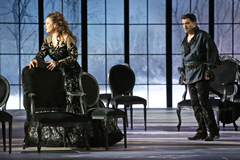| Opera Reviews | 5 May 2024 |
Sonya Yoncheva brings passion to a Bellini rarityby Silvia Luraghi |
|
| Bellini: Il pirata Teatro alla Scala, Milan 12 July 2018 |
|
|
After early work in Naples, Il pirata was Bellini’s first important success, and marked the composer’s fruitful collaboration with his favorite librettist Felice Romani. The plot has a romantic aura: the pirate Gualtiero, who had been in love with Imogene in the past, suffers a shipwreck close to the palace where she now lives with her husband Ernesto. Imogene is still in love with Gualtiero, while the very suspicious Ernesto hates him, fearing his wife’s lingering feelings. After encounters and confrontations, Gualtiero kills Ernesto in a duel. Condemned to death, he kills himself by jumping from a cliff, to the horror of Imogene, who raves in folly. This ending, which featured in the first version of the opera, was later modified with Gualtiero being executed by Ernesto’s men. The current production restored the original ending. The production was directed by Emilio Sagi, relying on the sets deigned by Daniel Bianco and the costumes by Pepa Ojanguren. In the first act, the stage is surrounded by mirror walls that give the impression of a marine setting, reflecting the long white gowns of the women who accompany Imogene. The background then changes, and shows the sea floor, a stony expanse with remnants of shipwrecks. In the second act, the snowy woods are somewhat at odds with the libretto’s location (Caldora, Ernesto’s dukedom, is in Sicily). In the end, Imogene breaks out in folly near her husband’s tomb, while a black veil falls over her. The finale with its ‘mad scene’ is a frequent feature of Italian romantic operas of Bellini’s age, and is a challenge for the soprano, who reaches it when she has already had to handle a very demanding score, calling for a dramatic yet agile voice. The protagonist, soprano Sonya Yoncheva, made it through the performance with honors, and received a worthy tribute of applause. The tenor role of Gualtiero is also challenging, as it calls for a ringing top with a solid center range. Piero Pretti showed a good technique, and tried to delve in the psychology of this complex character. Baritone Nicola Alaimo was a suspicious and short tempered Ernesto, with an authoritative voice. The chorus contributed strongly, prepared by chorus master Bruno Casoni, while Riccardo Frizza conducted the orchestra and the singers with a perfect mix of sound and voices.
|
|
| Text ©
Silvia Luraghi Photo © Brescia-Amisano / Teatro alla Scala |
|

 In spite of having had its very successful world premiere at La Scala, Vincenzo Bellini’s Il pirata has not been a frequent feature of the Milanese house. After the 1827 premiere, the opera had two 19th century revivals. A 1958 production starring Maria Callas has been its only appearance in the 20th century, making the current production a real discovery for a large part of the audience.
In spite of having had its very successful world premiere at La Scala, Vincenzo Bellini’s Il pirata has not been a frequent feature of the Milanese house. After the 1827 premiere, the opera had two 19th century revivals. A 1958 production starring Maria Callas has been its only appearance in the 20th century, making the current production a real discovery for a large part of the audience. 





